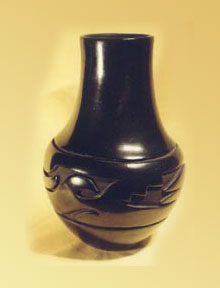![[map of Santa Clara]](../images/santa.jpg)
 lthough around 200 Santa Clara potters are currently
turning out stylish and highly priced blackware and redware, it wasn't always the case.
When Stevenson and Cushing made their first Indian pottery-collecting expeditions for the
Smithsonian in 1879, they gathered black, red, and micaceous bowls and storage jars from
Santa Clara, all undecorated. Sara Fina Tafoya is generally credited with development of
the first carved Santa Clara blackware in 1922. Later, her son Manuel, created deeper
carving, and by 1930 the two were doing carved ware that resembles modern Tafoya pottery. lthough around 200 Santa Clara potters are currently
turning out stylish and highly priced blackware and redware, it wasn't always the case.
When Stevenson and Cushing made their first Indian pottery-collecting expeditions for the
Smithsonian in 1879, they gathered black, red, and micaceous bowls and storage jars from
Santa Clara, all undecorated. Sara Fina Tafoya is generally credited with development of
the first carved Santa Clara blackware in 1922. Later, her son Manuel, created deeper
carving, and by 1930 the two were doing carved ware that resembles modern Tafoya pottery.
 y the end of World War ll, the Tafoyas sold their pottery
all over the southwest, paving the way for Sara Fina Tafoya's children, grandchildren and
great great grandchildren to become some of the most prestigious and highest priced
pottery groups in all of Southwestern pottery. And the tradition like the family continues
to grow robustly with the Naranjos, Chaverrias, and Gutierrezes adding ever more upper
level working potters to the family tree. The Tafoya's deeply carved design remained the
traditional expression until Popovi Da began experimenting at San Ildefonso in the late
1950's, along with his son Tony and Tse-Pe and Dora. y the end of World War ll, the Tafoyas sold their pottery
all over the southwest, paving the way for Sara Fina Tafoya's children, grandchildren and
great great grandchildren to become some of the most prestigious and highest priced
pottery groups in all of Southwestern pottery. And the tradition like the family continues
to grow robustly with the Naranjos, Chaverrias, and Gutierrezes adding ever more upper
level working potters to the family tree. The Tafoya's deeply carved design remained the
traditional expression until Popovi Da began experimenting at San Ildefonso in the late
1950's, along with his son Tony and Tse-Pe and Dora.
 mmediately behind them, Joseph Lonewolf and Grace
Medicine Flower started an entire parade of followers from Santa Clara who worked
intensively with inlaid coral and turquoise, double firing to create color changes on the
pot and deft fineline incision patterns that challenge the eye. Paul Naranjo, Stephan
Baca, Dolores Curran are all major artists in this subgroup of potters but whose tradition
has attracted so many young potters that it could well become Santa Clara's dominant
tradition in the future. mmediately behind them, Joseph Lonewolf and Grace
Medicine Flower started an entire parade of followers from Santa Clara who worked
intensively with inlaid coral and turquoise, double firing to create color changes on the
pot and deft fineline incision patterns that challenge the eye. Paul Naranjo, Stephan
Baca, Dolores Curran are all major artists in this subgroup of potters but whose tradition
has attracted so many young potters that it could well become Santa Clara's dominant
tradition in the future.
|
-
- ITEM# 0015P
Ron Suazo, Santa Clara.
- As one of the
potters who raised sgraffito designs and sienna coloring to impressive
heights, this piece is not only highly collectible but beautifully
rendered as well. The piece exhibits a bear claw pattern on one
side, sunburst pattern on the opposite side, and a feather pattern
with a single turquoise stone on each side.
-
- Size:
3" high by 3-1/8" diameter.
Price: $525. Mint Condition.
How to Order
-
-
 -
- ITEM# 0040P
Christina Naranjo, Santa Clara.
- As the daughter
of Sarafina Tafoya, Christina, and her sister, Margaret's carved
work changed the general perception of Santa Clara pottery. Both
continued raising the standards and worked in all their mother's
form.
-
- Size:
14-1/4" high by 9-1/2" diameter.
Price: $11,500. Mint Condition.
How to Order
More
Santa Clara Pottery 2 3 4
-
|

